How To Clean Acrylic Nail Paint Brushes
Preparing your nail brush thoroughly and correctly is the first stage to caring for your nail brushes. Read my previous guide for Scratch here. The second is maintaining this level of care throughout its use. Brushes do not last forever and need to be changed from time to time again but with the right care, you can significantly extend the lifespan of your brushes.
Using your brush
It is recommended that you keep different brushes for use with different mediums and it can also be good practice to use separate brushes for clear, colour, and glitter materials. A medium is the nail product which is used with that brush such as acrylic paint, gel paint, gel etc. However, this is not always possible.
If you cannot invest in several different brushes then it is vital to remove any previous medium in full before using with another medium, otherwise it will not work as you need it to.
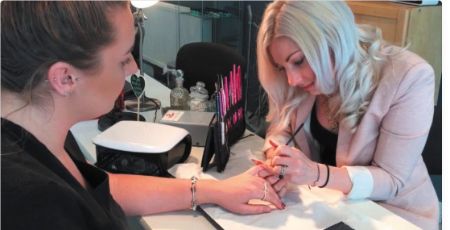
Cleaning your brush
Taking care during the cleaning process is essential in order to prolong the longevity of your brushes. Clean your brushes during and immediately after use and before storing again to prevent product building up in the bristles.
Firstly, ensure that all the liquids are removed from the metal ferrule after use to prevent discolouration. When you clean your nail brush after use, it is important to clean it in the liquid medium which you use with that brush e.g. acrylic brush in monomer, gel brush in clear gel or cleanser and so on.
When cleaning your brush, always take your time and be delicate and do not put force or splay out the bristles vertically. To prevent fraying or dishevelling the brush, reshape the bristles after cleaning them, wearing gloves to protect from product contact.
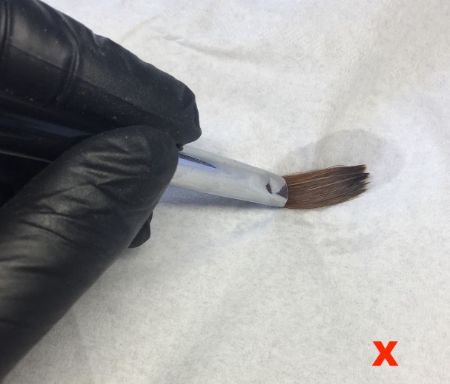
How not to clean your brush
Brush cleaners often use acetone as the main ingredient, and if you use it on a natural hair brush it can dehydrate the hair and make it fan out. It is recommended that you do not clean your brushes in acetone as this can dry the brush out. However, in extreme cases where monomer won't remove the acrylic because the acrylic has hardened, brush cleaners or acetone must be used. You can use a mix of monomer and acetone to prevent excess drying of your brush. Avoid soaking for long periods of time or leaving your brush stood up in acetone in your dappen dish, as the bristles will become kinked and damaged.
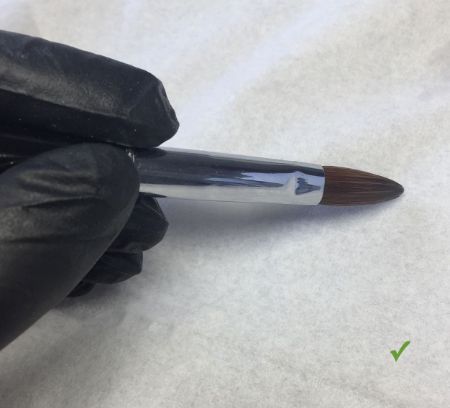
How to correctly clean your brush
After soaking the brush in acetone to loosen the hardened acrylic product, use a dish of clean monomer to repeatedly swish the brush and wipe out any remaining acetone then discard that monomer following COSHH guidelines. Brush cleaner or acetone that is left over in the brush can cause contamination which could lead to yellowing or product breakdown.
Gel brushes will either be made of natural or synthetic hairs but are cleaned and cared for in the same manner. Gel brushes should be cleaned in clear gel, and gel brushes you use for colour and glitter materials should be cleaned with brush cleaner or cleanser on a lint free wipe. Gently wipe the hairs until clear to make sure this is thoroughly removed.
An additional step of precaution must be taken when using gel with your nail brushes is preventing gel from curing in your brush.
It is important to make sure that you keep your brush away from UV light sources including sunlight, UV lamp, and overhead light while working or during storage to prevent any gel product curing in your brush. This damage is irreversible. You can replace the plastic sleeve for gel brushes if needed and pop a brush cap over to prevent any UV light accessing the bristles.
Natural bristle brushes require extra care and attention: leaving them in water or brush cleaners for extended periods of time will dry out and damage the bristles. After cleaning, thoroughly wipe the bristles gently, and store the brushes with their cap on. Using baby wipes, rather than water to clean your natural bristle brushes can be more conditioning to the brush, ensuring the bristles remain intact and don't dry out.
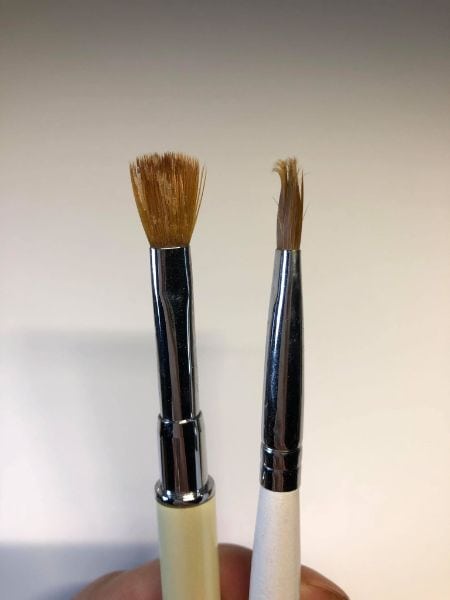
Ruined brushes
Storing your brushes
Brushes should be stored with the bristles facing downwards to prevent any liquids running back into the ferrule and causing damage such as breaking the adhesive which holds the bristles in place. The safest and cleanest place to store these is in a brush case, stored downwards which also prevents any fluff or dust contaminating your brushes or other tools knocking and damaging the bristles.
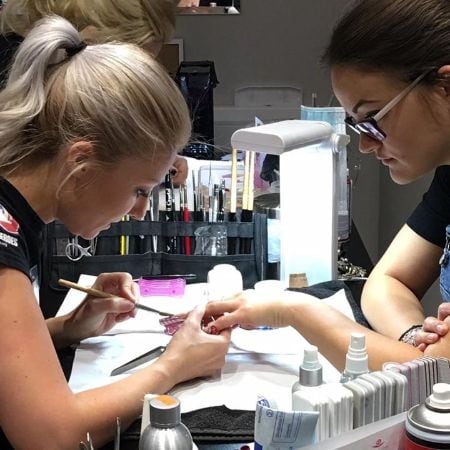
Life span
The life span of a brush depends on a number of things. There is no hard-and-fast rule for replacing brushes (assuming you are not changing products) – you want to replace the brush whenever the bristles start to fray or if you're finding it difficult to control the flow of product.
Take care of your nail brushes and they will take care of you.
Love Katie B x
www.katiebarnesacademy.com
How To Clean Acrylic Nail Paint Brushes
Source: https://www.scratchmagazine.co.uk/feature/how-to-properly-care-for-clean-your-nail-brushes/
Posted by: mccarterhable1977.blogspot.com

0 Response to "How To Clean Acrylic Nail Paint Brushes"
Post a Comment